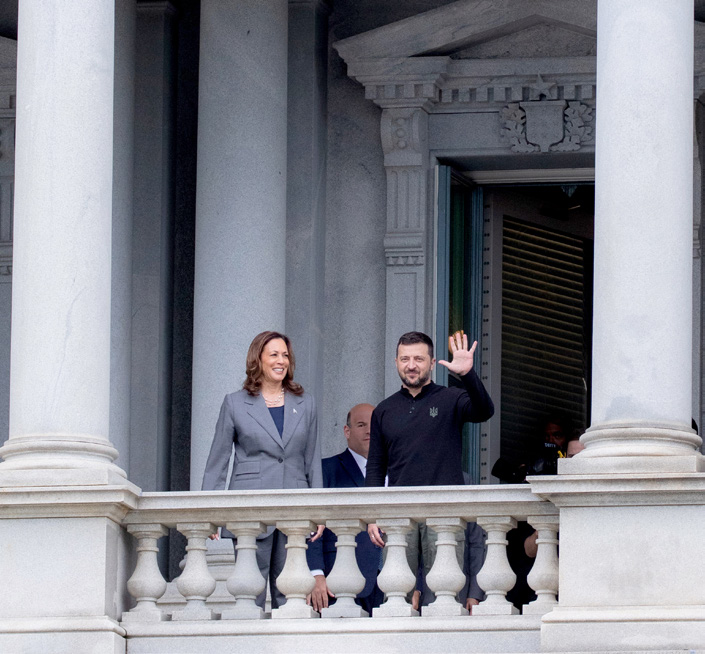
By Ross Douthat
Not every policy dilemma left unclear by Kamala Harris’ carefully ambiguous presidential campaign holds the same weight. For example, determining how Harris’ perspectives on the ideal health care framework have shifted since the pivotal Medicare for All discussions of 2020 is not exactly urgent, considering the high probability that her presidency would require collaboration with a Republican Congress, thereby rendering any broad domestic policy proposals ineffective.
Conversely, it is indeed more crucial to discern what actions a President Harris would take regarding the ongoing war in Ukraine, the most pressing crisis she would quickly face.
During Volodymyr Zelenskyy’s visit to Washington last week, we received a formal reaffirmation of Harris’ backing for the Biden administration’s stance from the war’s early days, which envisioned Ukraine reclaiming much of its lost territory: Standing alongside the Ukrainian leader, the vice president dismissed any negotiations involving territorial compromises as simply Putinist appeasement and “surrender proposals.” (The intended differentiation from Donald Trump is clear, as Trump has vowed to seek a ceasefire immediately while refusing to specify any terms.)
However, while the vice president was making this declaration, the administration was leaking skepticism regarding Zelenskyy’s alleged victory strategy, characterizing it as “merely a repackaged plea for additional weapons and the removal of restrictions on long-range missiles,” as reported by The Wall Street Journal. In other words, it is an appeal for assistance to mitigate the relentless pace of Russian advances, rather than a genuine plan for achieving the victorious resolution that both Kyiv and Washington have officially aimed for.
In fairness to Zelenskyy, it remains uncertain what form such a strategy could take, in the absence of direct NATO involvement, which the Biden administration has wisely avoided. The frontline dynamics have deteriorated against Ukraine over the past year, with the critical question being how severe the situation may become.
The Economist, reflecting a segment of the Western establishment, presents a starkly pessimistic outlook in its latest publication, highlighting Russian advantages in terms of personnel, firepower, and financial resources. Cathy Young, writing for The Bulwark, offers a more favorable perspective, contending that the current Russian offensive may soon reach its limits, and that Moscow might be aiming “to capture as much territory as possible before winter, hoping for a ceasefire that solidifies the status quo.” Yet both assessments converge on the understanding that Ukraine’s primary objective now is to stabilize the front, and the expectation of a swift Russian retreat that many hawks harbored in 2022 and 2023 has evaporated.
This scenario raises two layers of uncertainty about the possible actions of a Harris administration. The immediate concerns are how long the U.S. can maintain support for a victory “plan” that is essentially nonexistent, the extent to which Trump’s calls for negotiations could represent a probable conclusion for U.S. policy regardless of the November election outcome, and if both the Biden administration and Harris herself are merely hoping Ukraine can hold out until the election — after which their firm no-negotiation stance could become significantly more flexible.
The longer-range inquiries pertain to Ukraine’s role within American grand strategy, which is currently grappling with various perilous stress points. The initial expectation that the Ukraine conflict would neutralize one of our opponents appears increasingly misguided: Russia has withstood our economic assaults and seems to be thriving, at least for now, with a war economy closely tied to our larger adversary, Beijing. This Sino-Russian collaboration forms a critical component of a context that a recent bipartisan report from the Commission on the National Defense Strategy described as “the most serious and most challenging the nation has faced since 1945,” highlighting our vulnerabilities to key adversaries and “the potential for imminent major conflict.”
While there may be some exaggeration in that evaluation, it is certainly true that this is the most precarious time for American influence since the Cold War concluded, with challenges that necessitate either substantial rearmament, meaningful withdrawal, or a combination of both. The existing administration has grappled with this dichotomy, initially withdrawing chaotically from Afghanistan, and subsequently responding to emerging crises by doubling down on America’s commitments — yet lacking a coherent strategy to ensure these promises are feasible and to align our rhetoric with substantive strength.
In this light, Ukraine is not merely a significant strategic challenge in its own right but one point of decision among many, from the Middle East to East and Northeast Asia, that will evaluate the next president’s capability to prioritize, recalibrate commitments, and align our ambitious objectives with our more constrained resources.
Does Harris possess a distinct vision compared to the current president regarding the defense of the Pax Americana? Does she have any concrete vision at all? None of the unresolved questions surrounding her candidacy are likely to bear more weight, or yield answers that carry greater consequences, if the global landscape does not cooperate.
